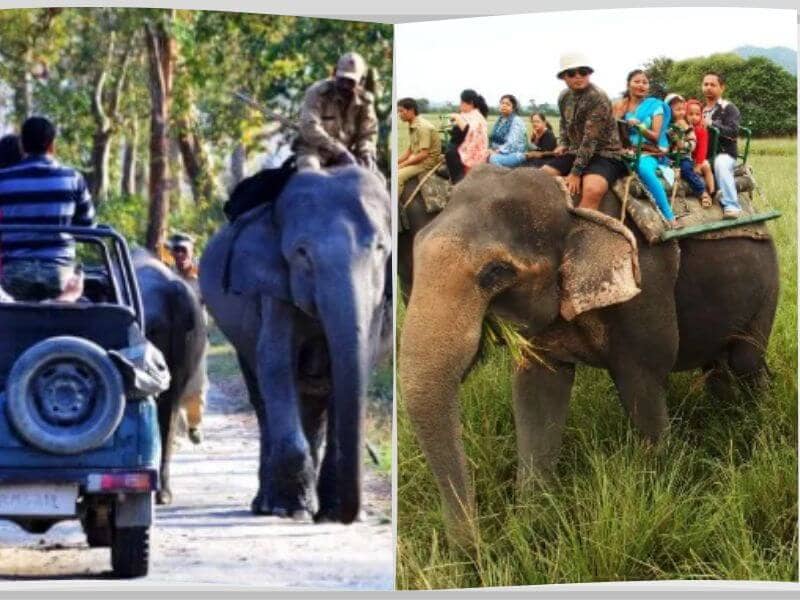Assam, one of the seven sisters of Northeast India, is known for its rich biodiversity and wildlife. The state is home to several national parks and wildlife sanctuaries, making it a popular destination for wildlife enthusiasts. Among these, Kaziranga National Park is one of the most famous and must-visit destinations for wildlife safari in Assam.
Kaziranga National Park: An Introduction
Spread over an area of 430 square kilometers, Kaziranga National Park is located in the Golaghat and Nagaon districts of Assam. The park is a UNESCO World Heritage Site and is home to the world’s largest population of the one-horned rhinoceros. Apart from rhinos, the park is also home to several other species of wildlife, including elephants, tigers, swamp deer, and water buffalo.
Kaziranga National Park: Wildlife Safari Options
There are two types of safari options available in Kaziranga National Park: elephant safari and jeep safari.
Elephant Safari:
Elephant safaris are a unique and popular way of exploring the park’s diverse wildlife. The safari takes place early in the morning and lasts for around one hour. Visitors can witness the animals in their natural habitat while sitting on the back of the majestic elephants.
Jeep Safari:
Jeep safaris are another popular way of exploring the park’s wildlife. Visitors can opt for a half-day or a full-day safari, depending on their preference. The safari takes visitors deep into the park’s interior, where they can spot several species of animals and birds.
Kaziranga National Park: Wildlife Safari Highlights
As mentioned earlier, Kaziranga National Park is home to the world’s largest population of the one-horned rhinoceros. Visitors can spot several of these magnificent creatures during their safari. Apart from rhinos, the park is also home to several other species of wildlife, including elephants, tigers, swamp deer, and water buffalo. The park is also a birdwatcher’s paradise and is home to over 450 species of birds.
Kaziranga National Park: Accommodation Options
Kaziranga National Park offers several accommodation options for visitors, including government-run lodges, private resorts, and eco camps. Visitors can choose from a range of options depending on their budget and preference. Some of the popular accommodation options in the park include Iora Resort, Kaziranga Golf Resort, and Diphlu River Lodge.
Kaziranga National Park: Best Time to Visit
The best time to visit Kaziranga National Park is from November to April. During this time, the weather is pleasant, and the park is open to visitors. The monsoon season, from May to October, is not a good time to visit the park as the park is closed during this time due to heavy rainfall.
Kaziranga National Park: Rules and Regulations
Visitors to Kaziranga National Park are required to follow certain rules and regulations to ensure their safety and the safety of the wildlife. Some of the rules include:
- Visitors are required to obtain a permit from the park authorities before entering the park.
- Smoking and littering are strictly prohibited in the park.
- Visitors are not allowed to get down from the elephant during an elephant safari.
- Visitors are not allowed to carry firearms inside the park.
A wildlife safari in Kaziranga National Park is a must-do activity for anyone visiting Assam. The park’s diverse wildlife, including the world’s largest population of one-horned rhinoceros, makes it a unique and memorable experience. Visitors can opt for either an elephant safari or a jeep safari and explore the park’s interior while spotting several species of animals and birds. The park also offers several accommodation options for visitors, making it a perfect destination for wildlife enthusiasts. Visitors can follow the park’s rules and regulations to ensure their safety and the safety of the wildlife.
Other Wildlife Safari Options
Apart from Kaziranga National Park, Assam is also home to several other national parks and wildlife sanctuaries, such as Manas National Park, Nameri National Park, and Pobitora Wildlife Sanctuary. These parks offer visitors the opportunity to spot several species of animals and birds in their natural habitats.
Again, Manas National Park, located in the western part of Assam, is another UNESCO World Heritage Site and is home to several endangered species, including the Bengal tiger, the one-horned rhinoceros, and the pygmy hog.
Similarly, Nameri National Park, located in the Sonitpur district of Assam, is known for its rich biodiversity and is home to several species of wildlife, including elephants, tigers, and leopards. Visitors can opt for a rafting adventure on the Jia Bhoroli River, which runs through the park.
And Pobitora Wildlife Sanctuary, located in the Morigaon district of Assam, is famous for its one-horned rhinoceros population. Visitors can opt for a jeep safari to spot these magnificent creatures.
Conclusion
In conclusion, Assam is a wildlife enthusiast’s paradise and offers several options for wildlife safaris. Visitors can opt for elephant safaris or jeep safaris to explore the parks’ interior and spot several species of animals and birds. The state also offers several accommodation options for visitors, making it a perfect destination for wildlife enthusiasts. Visitors can follow the parks’ rules and regulations to ensure their safety and the safety of the wildlife. A visit to Assam’s national parks and wildlife sanctuaries is an experience of a lifetime and should not be missed.
More Things to do In Assam
- Wildlife Safari
- Tea Garden Tour
- River Cruises
- Trekking
- Cultural Tours
- Adventure Sports
- Local Cuisine
